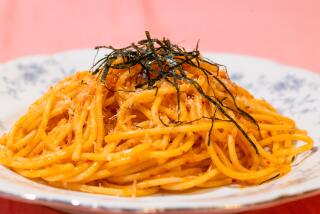Shrimp Is Coming Into Its Own as a Mealtime Favorite at Home and Out : Increased Availability Spurs Its Popularity
There could be a whole book written on shrimp. Now that this shellfish is coming out in the limelight more and more because of health reasons, availability and increased television commercials from restaurants and other promotions, questions on the consumer end are popping up. Here are some of the more common queries.
Question: I heard that shrimp is high in cholesterol. Is this true? How does it compare with other foods like chicken and eggs regarding cholesterol levels?
Answer: The cholesterol level of shrimp is higher than chicken, fish or lean beef, but is much less than eggs or liver. A three-ounce serving of cooked shelled shrimp (about six to seven medium) contains 175 milligrams of cholesterol. In comparison, three ounces of roasted chicken breast, skinned, contains 73 milligrams cholesterol while one large hard-cooked egg has 274 milligrams.
The moderately high level of cholesterol in shrimp, however, is offset by the following considerations: Shrimp has a low fat content, and fat promotes cholesterol absorption; it is generally consumed less frequently and in smaller amounts than beef or other foods because of its high cost.
Nutrition advisers recommend keeping daily cholesterol intake to 300 milligrams, so when consuming shrimp, limit your intake of other high-cholesterol foods.
Q: How can you judge the freshness of shrimp?
A: Let your nose be the judge. If there’s any hint of off odor like ammonia about them, the shrimp are over the hill. Shells should be bright and crisp. Avoid any that are soft and limp and those with extensive black spotting on the shell body or tail. The texture of shrimp meat should be firm, not mushy.
Q: What is the difference between scampi and prawn?
A: Often mistakenly applied to large shrimp, scampi is the name assigned to the tail of any deep-water, thick-shelled member of the lobster family. It is also known as Dublin Bay prawn, Norway lobster, French langoustine, Italian scampi or Caribbean lobsterette. The crustacean has some of the physical traits of lobster and shrimp. Scampi is also frequently used as a name of a shrimp dish with a buttery lemon-garlic sauce.
Prawn is the North American term for large shrimp varieties. Originating in England, the word prawn is still used in India, Hong Kong and some European countries to describe shrimp even with smaller-size species. It was the French and Italians who made the distinction between shrimp and prawn, using prawn for large varieties.
Q: What are freshwater prawns? They are sometimes sold on specials in the markets.
A: Also called giant, blue or Malaysian prawns, freshwater prawns are tropical or warm-water large shrimp that are fished and farmed in Asian countries as well as Hawaii. The shrimp are distinguished from other large varieties like the tiger prawns by their shorter and thicker tails. Least expensive of the tropical shrimp, freshwater prawns have a somewhat shorter shelf life. Their flavor is a little bland, and the texture softer, so they’re at their best cooked with a sauce rather than served plain.
Q: Are frozen shrimp treated with any preservatives?
A: Almost all shrimp imports and about half of domestic shrimp are quickly dipped in sodium bisulfites to retard enzymatic change (called melanosis or black spots) caused by oxidation. Overuse of bisulfites results in slippery shells that glisten and a much stronger iodine flavor.
Some shrimp, such as the deep-water Argentine red shrimp, are treated in a citric acid bath to enhance the color of the shrimp. Another preservative that has been used for years in some frozen shrimp is tripolyphosphate, which prevents moisture loss. All of the above chemicals are generally recognized as safe by the Food and Drug Administration, but through random sampling, frozen shellfish are being checked against use of higher than permissible levels of the preservatives.
Q: Other than purchasing strictly fresh shrimp, which I know are rare nowadays, which of the frozen shrimp items is a wiser buy: the peeled and deveined, the headless or head-on unshelled shrimp or tiny cooked cleaned shrimp?
A: The choice of the different shrimp forms in the market depends on how you’re going to prepare the shrimp, on customary preference (foreigners as well as Americans from the South often like the whole head-on shrimp) and on cost factors.
Economically and from a culinary standpoint, the large cooked, peeled and deveined shrimp are not as good a buy as frozen unpeeled shrimp. Unfortunately, the first type is more popular in this country, taking convenience into account. Since these shrimp have been frozen twice, first at sea and then in shoreside plants after they have been cooked and peeled, they are deprived of their natural juiciness and sweetness. These and the tiny cleaned shrimp, which are usually economical, are best eaten with a tasty sauce or in salads.
Q: What causes the deeper red color in some shrimp?
A: Shrimp that are caught in deeper water have a deeper red color than those caught closer to shore. An example is the red shrimp from Argentina, which is also treated with citric acid to retain the bright red color.
Q: Why do some shrimp taste strongly of iodine and others don’t?
A: The iodine taste is heavier in saltwater shrimp and less noticeable in freshwater varieties. Geographic variations in saltwater plus higher levels of sodium bisulfite increase the iodine taste in shrimp.
Q: I’ve noticed a lot of frozen cooked unpeeled whole shrimp (medium-size), which sometimes come in boxes. They’re also available in Chinese markets at a very low price. Can you tell me more about this type of shrimp? Do they need further cooking or rinsing?
A: These sweet-tasting arctic shrimp come from Alaska and the Gulf of Maine. They are favored for their sweetness and the fat inside the heads. The succulent roe between their legs is considered a true delicacy. They may be served partially thawed as is, with no rinsing or cooking, for appetizers or salads. Some people like to saute them quickly in a little butter, sometimes sprinkled with a dash of sugar to enhance the sweetness.
Q: Should frozen shrimp in the shell be thawed before cooking?
A: It’s best to thaw the shrimp for even cooking, particularly if they are large and if they have the heads on. To thaw quickly, let stand in cold water an hour or so (or longer for larger amounts). The preferred way is to thaw slowly in the refrigerator until loosened, sometimes as long as 16 to 24 hours. The cooking time also varies according to species. Cold-water species need less cooking time than warm-water types.
Q: What is rock shrimp?
A: Fairly new in the market, rock shrimp come from the coastline from Virginia to the Bahamas and in the Campeche Bay area. These lobster-like shrimp with an extremely hard shell are caught largely in June. Marketed as frozen, headless and shell on (about 31 to 40 shrimp per pound), rock shrimp are highly perishable.
Q: Should shrimp be deveined? They curl up in cooking when I cut them on the back to devein.
A: Smaller shrimp need not be deveined, but large ones, which easily show the black lines (intestinal veins) may be deveined. If you’re used to eating undeveined shrimp but you’re serving to guests who are squeamish, then you must pull those veins out. To prevent curling, the back need not be cut. Simply pull out the veins with a skewer on one part of the back close to the head. Or cook the shrimp before cutting the back and deveining.
More to Read
Eat your way across L.A.
Get our weekly Tasting Notes newsletter for reviews, news and more.
You may occasionally receive promotional content from the Los Angeles Times.










